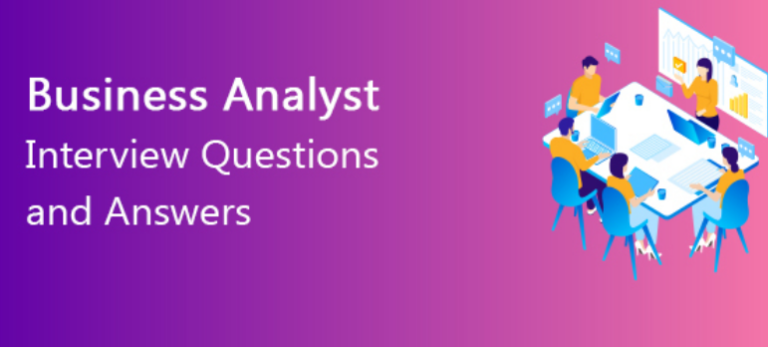A career in Business Analysis (BA) is not only rewarding but also essential for the success of many businesses. Business analysts are critical in bridging the gap between IT and business, helping companies achieve their goals by using data-driven solutions. If you are preparing for a Business Analyst interview, it’s crucial to be well-versed with the types of questions you might face. This guide will walk you through some of the most common BA interview questions, how to approach them, and tips to leave a lasting impression.
TOP BA Interview Questions
What is the Role of a Business Analyst?
Question: Can you describe the primary responsibilities of a Business Analyst?
How to Answer: Start by explaining that a Business Analyst is responsible for understanding business needs and translating them into technical requirements. Highlight key responsibilities, such as:
- Conducting research and analysis to understand business processes and identify areas for improvement.
- Gathering and documenting business requirements.
- Working closely with stakeholders, including clients, users, and developers.
- Facilitating communication between business and IT teams.
- Ensuring solutions align with business goals and strategies.
By providing a structured answer, you demonstrate a clear understanding of the BA analyst role and its importance in project success.
What Techniques Do You Use for Requirement Gathering?
Question: What methods do you use to gather requirements from stakeholders?
How to Answer: Discuss various techniques used to gather requirements, including:
- Interviews: One-on-one discussions with stakeholders to understand their needs.
- Workshops: Group sessions to gather information from multiple stakeholders simultaneously.
- Surveys/Questionnaires: Useful for collecting data from a large audience.
- Document Analysis: Reviewing existing documents, processes, and reports to extract relevant information.
- Prototyping: Creating mock-ups to visualize requirements and gather feedback.
Mentioning multiple techniques shows your versatility and adaptability in different project scenarios.
How Do You Handle Conflicting Requirements from Different Stakeholders?
Question: How do you manage situations where different stakeholders have conflicting requirements?
How to Answer: Highlight your conflict resolution skills by describing your approach:
- Active Listening: Understand each stakeholder’s perspective and underlying concerns.
- Prioritization: Use methods like MoSCoW (Must have, Should have, Could have, Won’t have) to prioritize requirements.
- Facilitating Discussions: Organize meetings to discuss and resolve conflicts.
- Compromise: Find a middle ground that satisfies all parties.
- Document Decisions: Keep a record of discussions and agreements to avoid future misunderstandings.
Demonstrating your ability to manage conflicts effectively is crucial, as it shows your capability to keep projects on track.
Can You Explain the Term ‘Use Case’ and Provide an Example?
Question: What is a use case, and can you give an example relevant to our business?
How to Answer: Define a use case as a description of how a user will interact with a system to achieve a specific goal. Use cases help identify and clarify system requirements. Provide an example:
Example: “For an online retail application, a use case could be ‘Customer Places an Order.’ This would include steps like browsing products, adding items to the cart, entering shipping information, and completing payment.”
Providing a relevant example helps demonstrate your understanding of use cases and their application in real-world scenarios.
What is UML, and How Is It Used in Business Analysis?
Question: Can you explain UML and its importance in Business Analysis?
How to Answer: Define UML (Unified Modeling Language) as a standardized modeling language used to visualize, specify, construct, and document the components of a software system. Discuss its importance in BA:
- Visual Representation: UML diagrams provide a clear visual representation of system architecture and design.
- Communication: Helps communicate complex system interactions clearly among stakeholders.
- Documentation: Serves as a comprehensive documentation tool that aids in understanding system requirements.
Mentioning different types of UML diagrams, such as Use Case Diagrams, Activity Diagrams, and Class Diagrams, can further showcase your knowledge.
How Do You Prioritize Tasks in a Project?
Question: Describe how you prioritize tasks in a project.
How to Answer: Explain your approach to task prioritization:
- Understanding Project Scope: Begin by understanding the project’s overall goals and objectives.
- Stakeholder Input: Gather input from stakeholders to understand their priorities.
- Urgency and Impact: Evaluate tasks based on their urgency and impact on project outcomes.
- Use of Prioritization Techniques: Mention techniques like MoSCoW, Kano Model, or Value vs. Effort Quadrant.
- Regular Reviews: Regularly review and adjust priorities based on project progress and changes in scope.
This shows that you have a methodical approach to managing tasks, ensuring that the most critical aspects are addressed first.
Can You Describe a Time When You Identified a Problem and Proposed a Solution?
Question: Give an example of a problem you identified in a project and how you solved it.
How to Answer: Use the STAR (Situation, Task, Action, Result) method to structure your answer:
- Situation: Describe the context or challenge.
- Task: Explain your role in the situation.
- Action: Detail the steps you took to address the problem.
- Result: Share the outcome and any positive impact on the project.
Example: “In a project aimed at improving customer service, I noticed that customer complaints were not being categorized effectively, leading to delays in response time. I proposed implementing a new ticketing system that allowed categorization by issue type, priority, and customer segment. As a result, response times improved by 30%, and customer satisfaction scores increased.”
Using real-life examples demonstrates your problem-solving skills and your ability to make tangible improvements.
How Do You Ensure That the Solutions You Propose Are Feasible?
Question: How do you validate that a proposed solution is feasible?
How to Answer: Explain your process for ensuring feasibility:
- Technical Feasibility: Collaborate with technical teams to understand system capabilities and limitations.
- Financial Feasibility: Conduct a cost-benefit analysis to ensure the solution is financially viable.
- Operational Feasibility: Consider the impact on existing processes and resources.
- Stakeholder Approval: Involve stakeholders in reviewing the proposed solution to gain their support.
- Pilot Testing: Implement a pilot or prototype to test the solution in a controlled environment.
By highlighting a structured validation process, you show that you are thorough in your approach to proposing solutions.
What Tools Do You Use as a Business Analyst?
Question: What are some tools you use regularly as a Business Analyst, and why?
How to Answer: Mention a variety of tools that cater to different aspects of the BA role:
- Documentation Tools: Microsoft Word, Google Docs for documenting requirements.
- Modeling Tools: Visio, Lucidchart for creating UML diagrams.
- Project Management Tools: JIRA, Trello for tracking tasks and progress.
- Data Analysis Tools: Excel, SQL, Power BI for analyzing and visualizing data.
- Communication Tools: Slack, Microsoft Teams for stakeholder communication.
Discussing various tools shows your versatility and familiarity with industry-standard software.
How Do You Stay Up-to-Date with Industry Trends and Developments?
Question: What methods do you use to keep yourself updated on industry trends?
How to Answer: Show your commitment to continuous learning and professional development:
- Reading Industry Publications: Mention popular BA and industry-related blogs, journals, or magazines.
- Attending Conferences and Webinars: Highlight your participation in relevant conferences and webinars.
- Networking: Discuss the importance of networking with peers through professional organizations like IIBA.
- Online Courses and Certifications: Mention any recent certifications or online courses you’ve completed.
- Learning from Experience: Explain how you learn and adapt from previous project experiences.
This demonstrates your proactive approach to staying relevant and informed in the ever-evolving field of Business Analysis.
Recommended To Read Also: Certified software tester certification
Conclusion
Preparing for a Business Analyst interview involves understanding the role’s nuances and being able to articulate your skills and experiences effectively. By familiarizing yourself with these common interview questions and crafting thoughtful, structured answers, you can showcase your expertise and stand out as a top candidate. Remember, interviews are not just about answering questions but also about demonstrating your problem-solving abilities, adaptability, and passion for the role. With thorough preparation and a confident mindset, you can navigate your BA interview successfully and take the next step in your career.


























